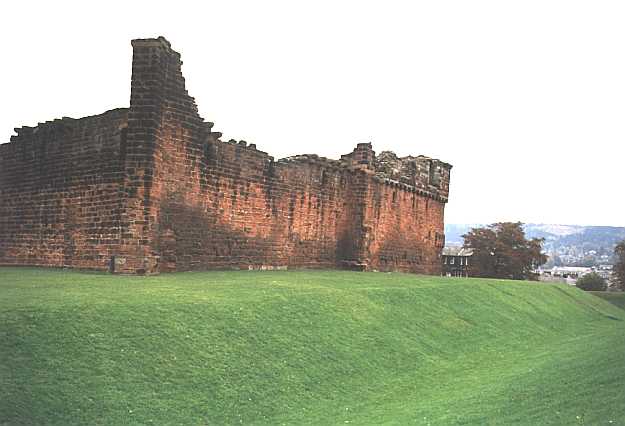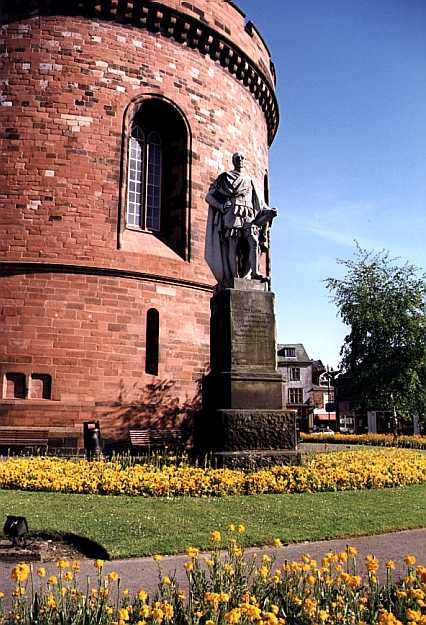PENRITH, to which we proceed from Carleton Hall, is a market-town containing about 4000 inhabitants. It lies on an easy inclination of the ground, and chiefly consists of one long street, stretching north and south. There are many well-built houses here, and the inhabitants are wealthy, courteous, and well-bred. The inns are numerous and respectable: those at which the mail-coaches stop, are the New Crown and George. - The church is a large and handsome structure, mostly new-built, except the lower part. Its roof is supported by pillars, consisting each of one entire stone dug out of a neighbouring quarry. In the church-yard are two ancient rude stone obelisks, set up at each end of what is called the Giant's Grave, and said to have been erected to the memory of Sir OWEN C∆SARIUS, a famous warrior, who destroyed the robbers and wild beasts that infested Inglewood Forest. Here are a good free school, a charity school, &c. with meeting-houses for Presbyterians and Quakers. Considerable improvements have been made. The old shambles, which were a nuisance, have been removed, and very neat and commodious ones erected behind the George Inn, on the plan of those at Carlisle. In point of amusement, Penrith has to boast of a newly erected and handsome assembly-room, and one of the first race courses in the North of England, on the west side of the Beacon-hill, and which has been walled in. The annual races and hunt are well attended, and conduce to the consequence of the place.
 The old castle, of which some remains are
yet standing, overlooks the town from the west, and gives it a majestic appearance. It has
nothing very antique in its members or ornaments; and the form of the windows, &c.
does not discover any thing to carry our idea much beyond the time of King Edward V.
The old castle, of which some remains are
yet standing, overlooks the town from the west, and gives it a majestic appearance. It has
nothing very antique in its members or ornaments; and the form of the windows, &c.
does not discover any thing to carry our idea much beyond the time of King Edward V.
Be this as it may, it is the general opinion that Richard, Duke of Gloucester, afterwards Richard III. resided here for some time. - This castle was dismantled in the time of Charles I. by the rapacious adherents of the commonwealth. The principal manufactures are those of checks, gingams, muslins, &c.- Penrith is distant from Carlisle 18 miles.
From Penrith-fell we see Greystoke Castle, the ancient and noble mansion of the Duke of NORFOLK, a few miles to the west; together with his Grace's extensive woods and deer-parks climbing up high grounds beyond. Proceeding onward we observe Plumpton Hall, the property of Miss SANDERSON. At Plumpton the road passes through the ruins of a Roman station. (See account of the Roman Wall). - There are several other genteel houses at a little distance from the road, on the west; viz. Hutton Hall, belonging to Sir FREDERICK FLETCHER VANE, Bart. but which is hid from view by the intervention of a deer park; Inglewood-house, the residence of Mr. JOHN BAXTER; Breckenbrough, belonging to W. WILSON, Esq.; Calthwaite Hall, the improved mansion of THOMAS DIXON, Esq.; ltonfield House, the property of HENRY OLIPHANT, Esq.; Peterill Green, belonging to Mr. COLLINS. We at length arrive at High Hesket, nine miles from Penrith, and as many from Carlisle. Leaving this village, we observe, on our left hand, Moorhouse-house, the residence of ISAAC PARKER, Esq.; Barrock Lodge, the pleasant, modern-built house of JAMES GRAHAM, Esq. standing on the verge of a high bank, half surrounded by the river Peterill, and looking down a fertile vale inclosed with wooded eminences; Wreay Hall, the property of THOMAS BENSON, Esq.; Wood-side, the exceedingly neat house of JOHN LOSH, Esq. having woods and plantations of considerable extent stretching from it in various directions; Newbiggin Hall, which surveys the vale of Peterill from a pleasant situation, and is the residence of the Rev. Mr. BATEMAN, who has made considerable improvements there; and Brisco-hill, the mansion of JOHN THOMLINSON, Esq.
We pass through the small village of Carlton,
and view Woodbank a little to the left, where is an extensive printfield under
the firm of MOUNSEY, LOWRY and Co. Toward the right, are the villages of Coathill
and Cumwhinton; and Durnhill-house1,
conspicuously situated, the improving seat of RICHARD LOWRY, Esq.; and on the opposite
direction the village of Upperby. Before crossing the Peterill, the bleaching
ground of Messrs. SCARROW, BAKER, & Co. is discerned to the left, lately occupied by
MESSRS. LAMB, SCOTT, WALDIE and Co. To th right are Scotby and Botcherby.
- On crossing Harraby-bridge, the first object which attracts our attention is the cotton
mill of Messrs.
ROTHWELL and Co. called the Mains, to the right; and a little to the left, the newly
erected work-house of St. Cuthbert's parish stands on a commanding situation, and has a
prominent appearance. A very little further, is the neat house and garden of Mr. HALTON,
on the road-side, and about 100 yards to the west is St. Nicholas, the property
and residence of JOESPH2 STUDHOLM, Esq. (which was formerly a
hospital for lepers). - Passing through the very elegant toll-gate and porter's lodge,
lately put up, we enter the suburb of Botchergate; where is the iron foundry of Messrs.
NICHOLSON and Co. The Court-houses, erected on the scite of the citadel, now catch the
eye. We enter English-street, and arrive at the Bush Inn, kept by Mr. T. WILSON, whither
the mail and other coaches arrive and from whence they depart alternately with the Crown
and Mitre. In English-street, is the wood-yard of Messrs. FORSTER & Co. and the cotton
and linen manufactory of Messrs. FERGUSON and DIXON.
enter the suburb of Botchergate; where is the iron foundry of Messrs.
NICHOLSON and Co. The Court-houses, erected on the scite of the citadel, now catch the
eye. We enter English-street, and arrive at the Bush Inn, kept by Mr. T. WILSON, whither
the mail and other coaches arrive and from whence they depart alternately with the Crown
and Mitre. In English-street, is the wood-yard of Messrs. FORSTER & Co. and the cotton
and linen manufactory of Messrs. FERGUSON and DIXON.
Opposite the market-place, in the centre of the city, is the post-office, (situated in St. Cuthbert's-lane) the Crown and Mitre Tavern, already noticed, (where the assemblies are held) and opposite to this is the newspaper subscription room, which is very well supported. We proceed along Scotch-street toward the Scotch-gate, so called from its situation. In this street the principal inns are the Grapes, Lion and Lamb, Blue Bell, and Duke's Head. Here also are the iron and wood-yards of Messrs. LEWTHWAITE and LIGHTFOOT, and near to the Scotch-gate is the iron warehouse of Mr. JOHN LONSDALE, the manufactory of Messrs. M'WILLIAMS and Co. and the wood-yard of Messrs. PORTERS and WAUGH; also the manufacturing concern of Messrs. JOHNSTON and GIBBONS. Near the bridge a road turns suddenly to the right, and leads to the Swifts, where the races are held.3 In this place are the wood-yards of Mr. ROWLAND and Messrs. FERGUSON and SOWERBY, and the hat-manufactory of Messrs. FERGUSON & Co. in George-street, where great improvements have been made. - Passing through George-street, we come into Spring-Garden-lane, where the bowling-green and tea-gardens attached to the Shakespeare tavern occasionally afford the citizens of Carlisle the opportunities of innocent amusement and gratification.
We now direct our course to the west of the city. Repassing the Scotch-gate, we advance toward the Irish-gate, and in our way thither, is the manufacturing concerns of Messrs. STODDART, in Finkle-street, also the timber-yard of Mr. NICHOLSON, and in Fisher-street the manufactory of Messrs. FORSTER. In this Street is kept the Carlisle Library4. In Annetwell-street is situated the timber-yard of Messrs. T. CARRICK and Co.
Leaving the Irish-gate directly to the right, we pass up Abbey-street, (where is Zion Chapel, in the Baptist connection), and through the Abbey, to the west walls, near which Messrs. PORTERS' iron and brass foundry is situated. We then descend the stairs of the sallyport - pass Mr. PATTINSON'S brewery and Mr. CLIFF's twist mill, and the work-shop of Mr. MARSDEN (a very ingenious manufacturer of the steam looms), adjoining to which are the extensive bleaching concerns of Mr. ROBSON CLARKE. - Passing Mr. HARRINGTON's leather-dressing manufactory, Mr. CARRICK's hat-manufactory, and Mr. BOUSTEAD's tan-yard, we come into Water Lane, where Mr. HAUGH's brewery and the Carlisle Cotton Twist Company's mill, and the one belonging to Messrs. COWEN, HEYSHAM, & Co. attract attention. Immediately opposite, at Long Island5, Messrs. HOLME have their manufactory for weaving, which is performed by the cast iron looms, that go by steam; and which they have had the credit of introducing into this part. From Water-gate-street we go up the Caldew to Cummersdale, about a mile distant, where the calico-printing and cotton-spinning businesses of Messrs FORSTER are carried on to a great extent. - From this place we return to Carlisle by the river; and in this direction many concerns are carried on; - in Denton-holme, the printfield of Messrs. LOSH and Co. and a small cotton mill belonging to Messrs. STODDART, and the premises lately occupied by Mr. R. CLARKE, now used by Messrs. HOLME for weaving; the Old and New Breweries - the former in Caldewgate, and the latter in Shaddongate, the iron foundry of FAULDER and Co.; and lately was burnt down a cotton-spinning mill occupied by Messrs. ROBSON and Co. - Without the Irish-gates are situated the hat-manufactory of Messrs. OWEN and THOMPSON, and the hat-manufactory, dye-house, &c. of Mr. F. BEATTIE. - There are, besides, several manufacturing and other concerns, of minor importance. - We proceed straight forward, and re-enter the city by the Irish-gate, which looks full up to Abbey-street.*
Any further information relative to this County will be
found in our History of Cumberland, and Houseman's Topographical View of the County and
Guide to the Lakes, to be had of the publishers of this work.
* It is not impertinent here to remark, that this district of the city may vie with any
other in being the residence of genuine worth and virtue. The benevolence and charity of
Mrs. Lodge and Miss Bowes (whose habitation is situated at the entrance of Abbey-street
from the Irish-gate) are too well known to require eulogy. Further up stands the
hospitable mansion of Misses Waugh, grand-daughters of a much-beloved Bishop of this
diocese, who are respected and beloved by both rich and poor. Misses Carlyle also reside
here: they have published a posthumous volume of Poems, the production of their lamented
brother; whose premature death deprived the world of the result of his travels in Greece,
Egypt, the Holy Land, &c. for literary objects, and of his remarks and observations on
the libraries and remains of literature at Constantinople, and various eastern
monasteries. The publication of these is a great desideratum in the learned world. In
Paternoster-row, adjoining to Abbey-street, lives the widow of the late much respected Dr.
Paley, one of the brightest ornaments of the county; and whose writings are become of
classical authority both with the patriot and the divine.
Jollie's Cumberland Guide & Directory 1811